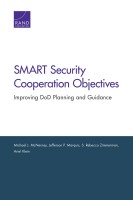| 来源类型 | Research Reports
|
| 规范类型 | 报告
|
| DOI | https://doi.org/10.7249/RR1430
|
| ISBN | 9780833094308
|
| 来源ID | RR-1430-OSD
|
| SMART Security Cooperation Objectives: Improving DoD Planning and Guidance |
| Michael J. McNerney; Jefferson P. Marquis; S. Rebecca Zimmerman; Ariel Klein
|
| 发表日期 | 2016
|
| 出版年 | 2016
|
| 页码 | 140
|
| 语种 | 英语
|
| 结论 |
Evaluation of Combatant Command Security Cooperation Objectives- Most individual country objectives did not meet the SMART criteria of being specific, measurable, achievable, relevant and results-oriented, and time-bound. In particular, most objectives were not yet measureable or time-bound, and their achievability could not be determined.
- Combatant command security cooperation planning was "SMARTer" than individual country objectives. Although most country plan objectives failed the SMART test, country plans overall and other supporting documents showed more-positive results.
- Combatant command security cooperation planning could benefit from greater standardization. Combatant commands have different objective hierarchies, and they do not define their terms in the same way.
- Responsibility and priority for developing country objectives differed by combatant command.
- Understanding of the SMART concept varied among stakeholders. For the most part, communication of the SMART concept was informal and ad hoc.
- SMART objectives did not adequately serve as a foundation for security cooperation assessment, monitoring, and evaluation. The entire security cooperation planning system needs to follow a SMART approach, with different levels of detail linking broad end states to concrete tasks.
|
| 摘要 |
- The Office of the Secretary of Defense (OSD) should provide SMART criteria and prioritization guidance to combatant commands and evaluate their performance accordingly.
- OSD and the Joint Staff should work with combatant commands to create a SMART security cooperation planning system centered around country plans. Creating SMART country objectives is not enough.
- OSD and the Joint Staff should work with combatant commands to establish a common theater planning hierarchy for security cooperation objectives, with standard terminology and a standard SMART objective review process.
- Combatant commands should integrate security cooperation elements of planning under a single authority.
- The U.S. Department of Defense should incorporate the SMART concept more formally into security cooperation training.
- OSD should establish a security cooperation framework that links SMART objectives to assessment, monitoring, and evaluation processes and requirements at the strategic and country level.
|
| 主题 | Military Force Planning
; Program Evaluation
; Security Cooperation
; United States Department of Defense
|
| URL | https://www.rand.org/pubs/research_reports/RR1430.html
|
| 来源智库 | RAND Corporation (United States)
|
| 引用统计 |
|
| 资源类型 | 智库出版物
|
| 条目标识符 | http://119.78.100.153/handle/2XGU8XDN/108299
|
推荐引用方式
GB/T 7714 |
Michael J. McNerney,Jefferson P. Marquis,S. Rebecca Zimmerman,et al. SMART Security Cooperation Objectives: Improving DoD Planning and Guidance. 2016.
|
|
文件名:
|
x1495316293489.jpg
|
|
格式:
|
JPEG
|

|
文件名:
|
RAND_RR1430.pdf
|
|
格式:
|
Adobe PDF
|
除非特别说明,本系统中所有内容都受版权保护,并保留所有权利。